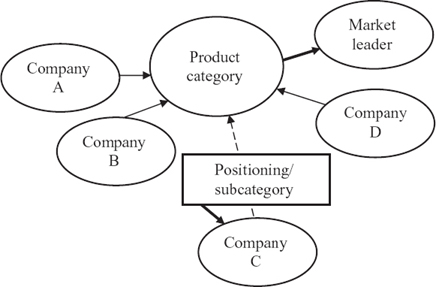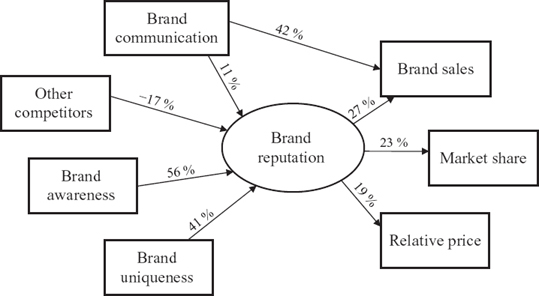17
The brain is lazy
We acquire habits that are difficult to break, and we are generally disinclined to change our behaviour. This is one of the most important reasons why so many innovations fail. The adjustments they required in human behaviour were simply too great. The brain tends to choose products based on preconceived patterns, which works to the advantage of established companies and brands.
Just as the brain has a tendency to get stuck in particular ways of thinking (riverbeds and thought tunnels), our choices and preferences within product categories become fixed due to what is termed conceptual fluency. Put simply, conceptual fluency means that we find it easy to understand and relate to a particular concept. By concept we mean here a product or a product category.
The easier it is to understand what insurance or a car is, the better we like it. Understanding what insurance or a car is at first glance might appear to be trivial in this discussion. Surely everyone knows what cars and insurance are, and this is true for most product categories. But as we know, the brain is lazy and doesn't like to exert itself more than absolutely necessary, so the faster it can understand something, the happier it will be. In other words, you can say that the faster an answer comes to mind, the better we like it (irrespective of whether it is actually right or wrong, since your brain considers that it is right if it comes quickly to mind). Our views of product categories are based on conceptual fluency, as illustrated in Figure 17.1.
We learn about a product category through our contact with a variety of products and our experiences of them. When you think ‘car’, you think of different brands of cars that you know, such as Volvo, Saab, Ford, BMW, Nissan, etc., and this is how you get your concept of cars. The lines in Figure 17.1 above represent the conceptual flows between companies and the product category. As you can see, the market leader has a thicker line than the other companies, which refers to the fact that the conceptual fluency in relation to the market leader will be stronger. When people think about the product category in general, they will tend to think first of the market leader and that is why the market leader has a bigger impact than other competing companies on how we perceive the product category.

It is rather like McDonald's coming to mind first when you think about fast food, or about Coca-Cola when you think about soft drinks. In this way, these companies define their product categories more than their competitors do and they are evaluated more positively (this becomes a circular argument in people's minds: McDonald's means fast food … means McDonald's). Often this is because the market leader was first to get its product to market and fastest to penetrate the market, and therefore was involved in introducing the product category when it was new (first-mover advantages). But this does not have to be the case. In fact, no matter how it occurs, the strongest conceptual flow wins – hands down. The faster we think of a product, the more that product will be favoured by the brain because it saves us energy, and consequently the better we will like the product.
In experiments with thousands of people, we measured their attitudes to and choice of brands in a range of product categories such as coffee and jeans to test the effects of the conceptual fluency of brands. As anticipated, the experiment showed that the more rapidly people thought of a brand, the better they liked it, and the more likely it was that they would choose that brand.
The conclusion of our experiment was that the most important goal for any business is to increase the conceptual flow from the product category to their product. If they can achieve that, consumer liking for and choice of their brand will follow automatically. In addition, other studies have shown that conceptual flow can change direction once it becomes sufficiently strong.
The company that has achieved the strongest conceptual flow has also assured the direction of that flow from the product category to their company (Figure 17.2). This means that people who think about the product category will think first of that particular company (‘I'm hungry and I want some fast food … McDonald's!’). For other competing companies with weaker conceptual flow, the direction of the flow will instead be largely from the company to the product category (‘Hmmm, Burger King … fast food!’). This means that the market leader has a dual advantage from its strong conceptual flow. Firstly, the market leader is likely to be at the top of people's minds when they think about the product category. Secondly, other competing companies will tend to remind people about the product category because of the reverse direction of conceptual flow for them, which in turn makes people think of the market leader.

To avoid the conceptual flow that is initiated in the minds of consumers by the products that lead straight back to the market leader, many brands try on cut this connection by positioning themselves in a subcategory, as Company C has done in Figure 17.3. By saying ‘we serve vegetarian fast food’ or ‘we are the ethical investment fund’ or ‘we sell electric-powered cars’, you create a subcategory that effectively blocks conceptual flow in the minds of the consumers from your company to the product category and back to the market leader. Instead, your company can enjoy the benefits of the same reversal of direction of conceptual flow in the subcategory that the market leader has for the product category. Such a strategy has been demonstrated to be effective in experiments in which people were made aware of a certain brand with the addition that it belonged to a subcategory (for example ‘Meaning Green – vegetarian fast food’) and they then selected this brand more often in preference to the market leader for the product category.

There are, however, two problems with positioning yourself in a subcategory to increase conceptual flow towards your company. Firstly, only a fraction of people will readily think about the subcategory – many more people will think ‘car’ than ‘electric-powered car’. In other words, the company will limit itself by being positioned in a subcategory.
Secondly, all subcategories ‘leak’. Electric-powered cars remind people to a certain extent of the product category ‘car’ and lead their thoughts into other conceptual flows. This is the explanation behind the rigid markets and market ceilings that we looked at in Chapter 4. Either the conceptual fluency of your product in the minds of consumers will be too weak to be a new company in the market, or you will limit yourself by attempting to position yourself in a subcategory. In addition, the more mature the market, the more subcategories it will have developed and the greater will be the competition in each of these subcategories. In studies it has been found that new products that create subcategories end up winning a smaller share of the market and achieving a lower level of profitability in the long term than new products that position themselves at the level of the product category.
In order to break free from rigid markets and achieve stronger conceptual fluency in relation to your product, you can work upwards instead of downwards by positioning in a new product category, preferably by merging two existing categories. By establishing a new product category, you maximize conceptual flow in the minds of consumers between your company and the category and avoid competition from other companies where conceptual fluency in relation to their products is well established. But you will instead be confronted with the problem of creating an understanding of the new product category in people's minds. People must be able to understand quickly and easily what use the product category is to them, and it must be something that springs to mind often. By merging two (or more) product categories, you can increase understanding for the new product category and, at the same time, maximize the conceptual fluency in relation to your product (Figure 17.4). People will then readily think about the category and thus readily think about your product.
By establishing a new product category with strong conceptual fluency in relation to your product, you can create new products and new marketing concepts for your existing products. Examples of new products include functional foods, which combine healthy/medicinal properties with food, mental training that combines therapy with sport (sports psychology) and Kinder Egg or Kinder Surprise, that combines confectionery with a toy. The product development behind Kinder Surprise was minimal, and was mainly concerned with developing a successful new marketing concept.

The best option is to communicate the name of the new product category by relating it closely to the original categories from which it has been derived as this will ensure that conceptual fluency is maximized and people can immediately create a picture in their minds and understand what the product offers. Not only will the new product category be easier to understand, it will also be helped along by the merged product categories generating conceptual fluency to the new product category, as shown in Figure 17.4.
Our habits contain an additional aspect of understanding. People have a tendency to display what we can call ‘Newtonian’ behaviour. This expression refers to the fact that our behaviour seems to follow Isaac Newton's laws of motion: i.e. that objects have their own inertia, which means that they do not change state willingly. To put an object that is at rest in motion requires energy, and to stop or change the direction of an object already in motion also requires energy. And that is just the manner in which humans function routinely. We create habits that are difficult to break, and we are loath to change and learn new ways of behaving. This is one of the most important reasons why so many innovations fail. The adjustments in human behaviour that they required were simply too great. Just think of how difficult it once was for banks to get people to stop visiting their branches and instead start using automatic teller machines, or using PCs to do their banking. If it hadn't been for the big savings involved for the banks – making their effort and the time required to get people to change these behaviours worth while – these changes might never have happened.
Because of our predisposition to Newtonian behaviour, it's important to know people's habits and try to relate to their existing behaviour patterns when you are trying to establish a new product category. Instead of doing something completely new, it's about ‘doing something else but in a similar way’.
The enormous power of conceptual fluency and the potential it has to create a new product category is summarized in Figure 17.5. It shows the results from a big American study of 160 brands in over 40 different categories covering a wide range of products including computers, newspapers and magazines, clothing and sweets. The researchers were looking for the common denominator that distinguished successful brands from the others across all types of products.
The researchers found that brand reputation is the common denominator affecting all aspects of the success of the brand in terms of sales, market share and relative price. Brands with a strong reputation sell bigger volumes irrespective of the size of their markets. They have a stronger position in their markets because they have a bigger market share and can charge a higher price than their competitors. Brand reputation was measured by asking over 4000 people their views on the brands. The brands with the strongest reputation were characterized by people perceiving them as successful, well-known and reliable.
To the far left of the figure are the factors that result in people perceiving a brand as successful, well-known and reliable, which leads to a strong brand reputation. At the top is brand communication, in the form of advertising and other communications activities. It is worth noting that brand communication has a direct impact on sales. This also backs up the reasoning in our previous discussion that you can generate conceptual fluency and be at the top of people's mind without necessarily being the market leader. The market leader has a natural head start, but companies that come after the leader can narrow the gap by maximizing their presence. The more often people hear and see the brand, the more readily (faster) they think about it and choose it.
As we can see, there is a strong link between brand awareness and brand reputation. The figures show that brand awareness has a 56% effect on brand reputation, which means that if brand awareness is increased by 10%, reputation will increase by 5.6%. This shows how strong conceptual fluency can be. When the brand comes to mind more readily than others, the brand appears to be more and more successful, well-known and reliable. People thus become significantly more likely to purchase that brand and pay a higher premium.
The number of competitors and brand uniqueness mirror each other. The fewer the competitors, the more unique is the brand. The main difference is that the number of competitors is measured as actual competitors in the same product category, while brand uniqueness is measured by asking people how unique they perceived the brand to be. Not surprisingly, we can see that perception of brand uniqueness has by far the bigger effect of the two. The effect of brand uniqueness on brand reputation illustrates clearly the power in establishing and defining a new category instead of jostling for position with other companies in a mature product category. By communicating a new category and a new concept, the brand is not compared with those of other companies but creates for itself a unique position and reputation.
This study functions as a good way of summing up this section on conceptual fluency. The brain tends to choose products based on preconceived patterns, which works to the advantage of established companies. The more readily a product category comes to mind, the better people like it and the more they use it. The more readily a brand comes to mind when we think about a product, the better we like it and the more often we purchase it, and the more we are willing to pay more for it. To strengthen conceptual fluency in relation to your product, you can position yourself in a subcategory (thus cutting off conceptual flow from your product to the product category), increase your presence through brand communication, or create a new product category. However, positioning yourself in a subcategory carries the risk of limiting the brand and serving to reinforce the market ceiling.
Brand communication requires creativity in expression to avoid being encumbered by leaking buckets and a low rate of efficiency. Creating a new product category makes the brand unique, but also requires that the category is easy to understand and does not go against people's Newtonian-type behaviour.


